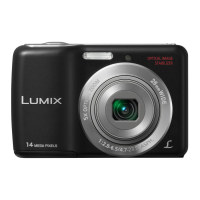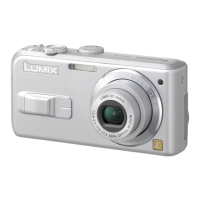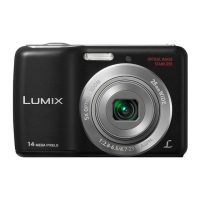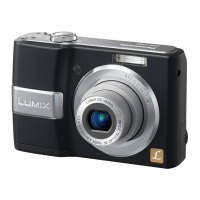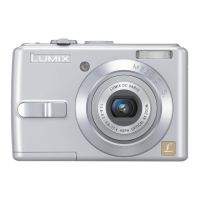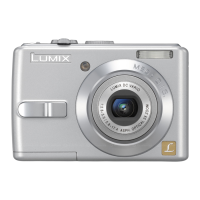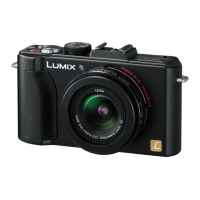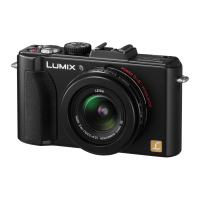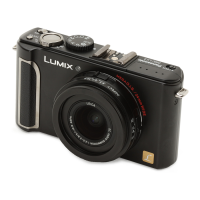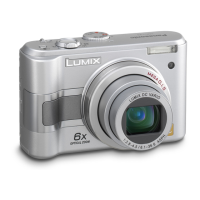Do you have a question about the Panasonic DMC-LS6 and is the answer not in the manual?
Safety precautions for using the camera, avoiding damage and malfunctions.
How condensation forms and how to deal with it to prevent camera damage.
Advice to take a test shot before important events to ensure correct recording.
Statement that the company is not liable for missed shots due to technical issues.
Guidance on legal use of recordings, noting restrictions on copyrighted material.
Cross-reference to another section for additional safety and usage guidelines.
Information about optional items like memory cards and how to obtain replacement parts.
Explanation of the cursor button functions and their related operations.
Details on battery life and picture capacity based on battery type and usage conditions.
Instructions for safely removing batteries and memory cards from the camera.
Information on where pictures are saved (built-in memory vs. memory card).
Details on compatible SD, SDHC, and SDXC memory cards recommended for use.
Details on how to access and change the clock settings via the menu.
Proper camera holding techniques to prevent shake and ensure good shots.
Guide on selecting flash modes and understanding flash indicators.
Explanation of how the camera automatically detects scenes for optimized settings.
Explanation of different zoom types and their functionalities.
Instructions on how to zoom in on pictures during playback.
Controls for pausing, playing, rewinding, and fast-forwarding motion pictures.
How to return from multi-screen display to single-screen display.
Steps to switch between multi-screen and single-screen views.
Instructions for deleting multiple or all pictures at once.
Overview of the camera's menu screen layout and button functions.
Explanation of different menu types like Setup, Rec, and Playback menus.
Step-by-step guide on how to change a specific menu setting using an example.
How to set the camera's time, date, and display format.
How to adjust the volume of the camera's beep sounds.
How to adjust the volume of sound output from the speakers.
How to configure the camera to automatically turn off after a period of inactivity.
How to correct flickering on the LCD monitor caused by lighting conditions.
How to automatically display still pictures immediately after they are taken.
How to reset camera settings to their default values.
How to check the current version of the camera's firmware.
How to format the built-in memory or memory card, erasing all data.
How to change the language displayed on the camera's screen.
Overview of different recording modes available on the camera.
Information on the camera's focus range and distance to subject.
Explanation of different flash types and their respective uses and operations.
Table showing flash availability across different recording and scene modes.
Details on the effective range of the flash under different zoom conditions.
Overview of the scene menu options available for specific shooting situations.
Optimizes settings for skin tone of subjects in bright daylight conditions.
Specific mode for taking self-portraits, often recommending a self-timer.
Captures clear pictures of wide, distant subjects effectively.
Guides users to capture multiple shots for creating a panorama image later.
Captures fast-moving subjects like sports with optimized settings.
Captures people and nightscapes with accurate brightness.
Takes clear pictures of night scenes, allowing for slower shutter speeds.
Captures natural-looking pictures of food items.
Brightens subjects and backgrounds for indoor events like weddings.
Uses weak flash to enhance skin tones and allows recording of age.
Captures clear pictures of scenes such as sunsets.
Prevents blurring of subjects in dark, indoor conditions.
Takes clear pictures of fireworks in the night sky.
Captures clear blues of the sky and sea without darkening subjects.
Brings out the natural color of snow in ski slopes and mountain scenes.
How to set the number of pixels for still pictures, affecting capacity and quality.
How to set the picture size and frame rate for motion pictures.
How to manually set ISO sensitivity for clear pictures in different lighting conditions.
How to adjust coloring to match light source for natural-looking colors.
How to change focus alignment methods based on subject position and number.
How to multiply optical zoom effects, noting potential picture quality reduction.
How to take rapid succession of still pictures while the shutter button is held.
How to set color effects for pictures, choosing from standard, vivid, B&W, or sepia.
How to automatically detect and correct red-eye when using flash.
How to automatically detect and prevent camera shake (jitter).
How to add recording date and time stamps to still pictures.
Sets the camera's internal clock, same function as in the Setup menu.
Standard mode for viewing pictures one by one.
Automatically plays back still pictures in sequence.
Allows narrowing down pictures displayed by selecting a category.
Controls for managing the slide show playback, like pause, next, and stop.
How to adjust duration and repeat settings for slide shows.
How to reduce picture size for email or web use.
Resizes multiple pictures at once, up to 50 images.
Steps to connect the camera to a computer using a USB cable.
How to select the PC connection mode on the camera.
General instructions for operating the camera via computer.
Explains the standard folder and file naming conventions used by the camera.
Steps to connect the camera to a PictBridge-compatible printer.
How to select the PictBridge (PTP) mode for direct printing.
How to initiate the printing process and select print settings.
Explanation of various icons and information displayed on the LCD during recording.
Explanation of various icons and information displayed on the LCD during playback.
How to handle messages about pictures that cannot be deleted, often due to format.
Explains limits on the number of items that can be selected for deletion or resizing.
Troubleshooting steps for system errors, often involving power cycling.
Reasons why pictures might not be copied, such as duplicate names or non-DCF formats.
Addresses messages related to insufficient storage space on the camera or card.
Troubleshooting for errors related to the camera's built-in memory.
Guidance for incompatible or erroneous memory cards, suggesting formatting.
Instructions for when card access fails, recommending reinsertion or a different card.
Covers errors related to memory card compatibility (SDHC/SDXC) and parameters.
Troubleshooting for data read/write failures on the memory card.
Addresses issues with motion picture recording cancellation due to slow card write speeds.
Explains what to do when the maximum number of folders or files is reached.
Troubleshooting common issues related to camera power and battery performance.
Solutions for problems like inability to record, white pictures, or incorrect exposure.
Addresses issues with picture quality like coarseness, interference, or red banding.
Troubleshooting for motion picture recording interruptions, often related to card speed.
Solutions for LCD monitor problems like shutting off, unstable brightness, or flickering.
Troubleshooting for issues where the flash does not emit or is disabled.
Solutions for problems viewing pictures, such as black screens or incorrect folder numbers.
Addresses playback issues like low volume, white spots, blackened red areas, and motion picture sound.
Troubleshooting problems related to connecting the camera to a computer or printer.
Solutions for miscellaneous issues like incorrect language, camera heat, clicking noises, and clock errors.
General precautions and warnings regarding camera operation and environmental factors.
Instructions for cleaning and maintaining the camera's exterior.
Advice on storing the camera and its accessories when not in use.
Precautions for handling memory cards to prevent damage and data loss.
Cautions regarding handling the LCD monitor and its behavior in cold conditions.
Important notes on battery usage, storage, and handling to ensure safety and performance.
Specific guidance for using and charging rechargeable Ni-MH batteries, including memory effect.
Guidance on managing personal information stored on the camera before repairs or disposal.
Details on supported recording media like built-in memory and various SD card types.
Lists available pixel resolutions for still and motion pictures.
Specifies the file formats used for still and motion pictures.
Details about the digital interface and terminal used for connection.
Physical dimensions of the camera.
Weight of the camera with and without card/battery.
Specifies the recommended operating temperature range.
Specifies the recommended operating humidity range.
| Sensor Type | CCD |
|---|---|
| Sensor Size | 1/2.33 inch |
| Optical Zoom | 5x |
| Digital Zoom | 4x |
| ISO Range | 100 - 1600 |
| Shutter Speed | 8 - 1/2000 sec |
| LCD Screen Size | 2.7 inch |
| Video Resolution | 1280 x 720 |
| Storage media | SD/SDHC/SDXC |
| ISO Sensitivity | 100, 200, 400, 800, 1600 |
| Battery Type | Lithium-ion |
